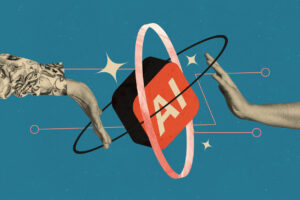How AI helped a research pro with no coding experience build a software tool
Reputation Leaders created a tool for categorizing open-ended survey responses — with no coding experience at all.

Coding open-ended responses by hand is a time-consuming task for any PR or research professional gathering sentiment or feedback. Even with some automation, the tool is often clunky and clumsy.
But Harry Morris, a project manager at Reputation Leaders, saw an opportunity to use AI to create a program to speed up the process. And with no software coding experience, he did just that, with a little support from Head of Operations David Lyndon.
Here’s how they pulled it off — and how you might do the same.
Answers have been edited for brevity and clarity.
How did you start investigating AI at Reputation Leaders?
Morris: We run a lot of surveys, we ask a lot of open text questions where people can type their responses. We use a statistics program that can automate some of it, but generally it always takes a couple of days if there are a lot of responses. And I thought that I could probably build something. I’ve always thought coding is cool, but I’ve never been able to actually do it, other than just little bits of JavaScript, which actually David taught me with his background in software engineering. But with the progress of ChatGPT, it’s code generation is starting to get very good.
I wanted it to get the list of open-ended responses and classify them into categories, but better than just picking up on groups of words, which is basically what statistical models do.
I had a direction and put it into ChatGPT. Through the process of having a back and forth with the AI, you form the idea as you’re having that conversation.
I’m saying ‘we’ as if ChatGPT was a person, but it does kind of feel like that when you’re in the process. Probably 20 minutes into that conversation, I had a well full thought-out idea of what I wanted to build. And then I said, ‘Right, we’ve got an idea. Code it.’
It spat out this long, long, jumbled list of a lot of things. And I didn’t particularly understand what was going on. I took it and put it in the Google Sheets. You can run code into the back end of Google programs, kind of similar to what you can do with Excel. I put it in, tested it and it didn’t do anything.
I thought it was going to work first time, but it completely didn’t work. As soon as I had a problem though, I could grab the error, grab the snippet of code, put it back into GPT, iterate, test, and then fix each part. That took a bit longer, but after a couple of hours it worked pretty much as I wanted, which blew my mind a little, because this was the first time we had tried anything like this.
Walk me through the ‘conversation’ you had with ChatGPT defining your idea. What was it like brainstorming with a robot?
Morris: I didn’t start with anything too complicated. It was a couple of lines, — I wanted it to take in a list, give me some themes, and spit out some categories. Then go back and put each response into those themes. It came back and questioned me, asking, ‘Have you thought about this? Have you thought about the length of the categories? Have you thought about how many there should be? Have you thought about X, Y and Z?’ I could move through that conversation and cherry pick the bits that I liked.
You had very little experience in coding, yet you did troubleshooting on code. How did that work?
Morris: Most code runners will point out the row that isn’t working, and because I knew what I wanted at the end, I could add in checks to see, for example: “right, at this point, what is this variable?’
Throughout that whole process, if I didn’t know what I was doing, ChatGPT has an understanding of the programming languages, so I can tell it in basic English what I need, i.e. ‘I want to add a stop that tells me what variable A is at this point in the code’, and then I put that back into the code runner, and then it runs it again. And you build an understanding through that process.
David, you do have experience in coding and with software. What did you make of this process?
Lyndon: Yes, it’s funny listening to Harry talk about it, actually, because, ‘code runner,’ for example, that’s not language that any software engineer is ever going to use. But of course, it makes absolute sense in normal speech, and AI allows you to do that.
When Harry came to me with the with the output, and showed me what he’d done, part of me was just hugely impressed, because it was a piece of software that worked from beginning to end and did exactly what he wanted it to do.
Another part of me was hugely frustrated, because if I want to do that, I’ve got these skills that mean I could do it, but actually it would have taken me a long time, even with all the skills that I’ve built up over 25 years. I would still have had to go through that process of coding and testing. So getting to see the end result and saying, wow, Harry’s actually just persevered through this process, and it allowed him to get from concept to product in a reasonably short amount of time is hugely impressive.
So could you ballpark how long this would have taken you to do the old-fashioned way?
Lyndon: If I had taken this and I just had time to code it myself, I would say six to eight hours.
And Harry about how long did it take you to do this?
Morris: I’d say, to get it to the point where I showed David, it was probably double that.
Lyndon: Yeah, but I have 25 years’ experience. So it’s 25 years plus six to eight hours.
Once you had this tool in working condition and you deployed it, how has this impacted your workflows?
Morris: We did the calculations for it. It probably cost us £60 pounds in costs, then man hours between £700 and £1000, so all-in, just over £1,000 UK to build this. Using this tool would be about 20 times faster than doing the process manually.
In a project last week, I grabbed some comments from an article and ran it through the code. It took me five minutes to add, but we talked through it at length during the final client presentation, because they thought it was useful.
So this is really changing your client product in a lot of ways.
Lyndon: It’s increasing quality. It’s increasing the depth of the analysis that we can do. It’s saving us time, yeah, but it’s not forcing us to change the way that we work, the way that we do things.
Where do you where do you go from here, now that you have this foundation?
Lyndon: I think the limit right now is imagination. So what can you imagine this doing? And then go and test it. Sometimes it’ll work and sometimes it won’t, but right now it’s so new. We don’t know what those guidelines are. We don’t know what those barriers are. We don’t know what the limits are.







